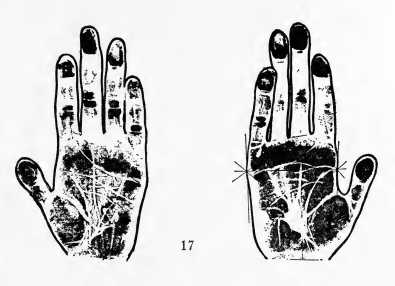The Thumb
Table of Contents
Professor G. Elliot Smith determined that the Peking Man was human and not an ape by looking at its thumb.
More than any other member, the thumb marks man as different from the beasts.
The thumb is the secret that distinguishes the leader, creator, and successful man from his fellows.
The thumbs of an ape are so short and rigid (plate 17).

In the hand of man, the thumb is opposable. It can swing in an arc and touch every one of the other fingers. An ape’s thumb cannot.
Our manual dexterity, our ability to handle tools, to create, to build, to write, to guide fine instruments, we owe to our thumbs.
Large And Small Thumbs
The thumb governs the general qualities of will, reason and appetites.
Therefore, the thumb and fingers must be considered together. The thumb will usually tell what use we put our gifts to.
A large thumb strengthens the qualities of weak fingers, deficient in energy and practicality.
It also emphasizes those qualities in a hand already having energy and will, perhaps to an extent which may be brutalizing.
A large thumb adds quickness and determination to the practicality of short fingers. A small thumb negates the force of such hands.
A large thumb is excellent with long fingers, for it bolsters their method and thoughtfulness. A small thumb makes the long-fingered person fussy and irritable, conscious of small details but unwilling or unable to work methodically.
Conic or pointed fingertips with a small thumb show artistic feeling but no creative power.
Add a large thumb to such fingers, and you are likely to have a poet or artist. Large thumbs increase the power and energy of spatulate tips and give direction and purpose to square hands.
Small thumbs always detract from the positive qualities of a hand, not so much by lessening the talents as by interfering with their application.
The normal thumb, when held straight up along the side of the hand, should reach to about the middle of the index finger’s base phalanx (see plate 18), and its second and third phalanx should be of equal size.
The Thumb’S Setting
The relative height of the thumb measured by the first finger differs with the setting of the thumb whether high or low on the hand. Often a low-set thumb, even when it is long, will reach only to the base of the first finger.
The lower on the side of the hand the origin of the thumb, the greater the intelligence, as a rule.
When the thumb is set low (see plate 19), it is able to move in a wide, sweeping arc, indicating a generous, liberty-loving, independent and sympathetic person.
When the thumb is high-set (see plate 20), especially if it is held close to you will find a secretive, cautious and timid disposition.
If thumb is set very close to the hand and appears inflexible, you can expect meanness and suspicion.
But if the other aspects of the hand are good, the close setting may indicate only lack of self-confidence, shyness and oversensitiveness. This is particularly so in persons who normally hide their thumbs in the half-closed palm.
A medium setting of the thumb with free movement at the side of the hand indicates a person who is well balanced, neither extravagant nor mean, neither obstinate nor weak-willed; frank, honest and loyal.
The Thumb’S Phalanxes
The thumb has 3 phalanxes.
- The first (plate 14, TH-A) governs will
- The second TH-B governs reason and logic
- The third TH-C governs feeling and appetites
When the will phalanx is excessively developed, stiff and very much larger than the reason phalanx, the person will be obstinate with a violent temper and the need to impose his own will and desires on others.
A more delicate tip on a highly-developed will-phalanx modifies its brutality with sensitiveness.
A square tip gives us a very unimaginative, stubborn person, a fanatic in his own narrow way.
When the will-phalanx is too short in proportion to the rest of the thumb, we can expect weak will, a person easily influenced by others and falling for every temptation. A pointed or tapering end on a short will-phalanx indicates almost hopeless weakness.
A forceful tip on a short will-phalanx diminishes the weakness.
The Phalanx Of Reason
The second thumb phalanx governs perception, judgment and reasoning powers. If long, it gives the ability to plan to make decisions, to use sound judgment. When a long second phalanx is combined with a short will-phalanx, you find a person who can make intricate plans but falls short in their execution.
On the other hand, a deficient phalanx of reason with strong will, leads to action which may often be foolish or misapplied. Waisted formation of the phalanx of reason goes with an ability to make fine distinctions.